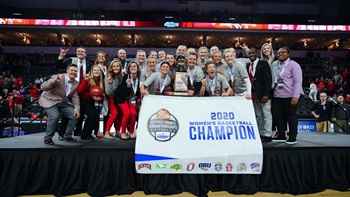Competitive research leads to Goldwater Scholarship for USD student Jennifer Dumdie
Dumdie, a 2008 graduate of Selby Area High School, is currently working with Kathleen Eyster, Ph.D., focusing on endometriosis, a disease in which endometrial tissue escapes from the uterus and implants in the peritoneal cavity. It is considered a common cause of infertility and chronic pelvic pain in women. Rather than wait patiently and observe in the laboratory behind Eyster, Dumdie took a hands-on approach and works right beside Eyster.
“She wanted to write a grant proposal to seek external funding for the endometriosis research, and she wanted to apply her knowledge and interest in mathematics to develop a mathematical model of endometriosis,” described Eyster, professor of Basic Biomedical Sciences. “It’s unusual for an undergraduate to seek a lead role in a major research project, but her additional interests are even more unusual.”
Those additional interests, Eyster explained, include Dumdie writing a research grant proposal using not just a biology model but a mathematical model, too. In fact, Dumdie is the first student in Eyster’s 23 years of working with undergraduate researchers to express an interest in writing a research proposal.
“Dr. Eyster is great to work with and she was very open to the math model for our research,” said Dumdie, the daughter of Rob Dumdie of Selby, S.D. and Deb Dumdie, also of Selby, S.D. “I thought it would be a unique opportunity to gather data from two different sources, develop grant proposals from both the mathematical data and biological data, and submit that information to acquire more funding for our research.”
“Jennifer is indeed a unique undergraduate researcher,” Eyster added. “Most undergraduates are content to take on a simple research project and perform the assigned experiments. She is the first in my experience with undergraduate researchers to take an idea and expand it in new directions that utilize her skill set and interests in a way that adds a new dimension to a research project.”
Ironically, Dumdie had not worked in a lab or on research prior to her sophomore year at USD, even though she was a biology major. Her first experience was working in a cardiology lab at the University of California, San Diego in the summer of 2010. When she returned to campus that fall, she actively pursued work alongside Eyster. After getting settled in with the endometriosis research, Dumdie wasn’t afraid to go beyond the lab and seek additional resources from another faculty source, José Flores, Ph.D., professor of Mathematics.
“Jennifer was interested in developing and implementing a mathematical model to complement the study of quantifiable parameters of endometriosis,” Flores added. “Jennifer approached me late last semester with the idea of the project. I was fascinated to have the opportunity to mentor a student who wants to explore mathematical modeling to complement her research in the biomedical sciences.”
Needless to say, the research is ongoing. Dumdie presented part of the endometriosis model at USD’s 2012 IdeaFest last month, but hasn’t stood still for very long since. She insists that carrying a double major isn’t too strenuous on her schedule, after all she had chosen math as a minor so adding a few more classes wasn’t a stretch, but she regrets getting involved late in the labs after already spending a couple of years on campus.
“I should’ve started doing research a little earlier, before the summer after my sophomore year,” admitted Dumdie, who is scheduled to graduate in May 2013. “But I think the future of research involves incorporating multiple components or the capacity to analyze using different areas. If you have the ability to look at something from two different perspectives and you can pursue it, then I think it’s important to go after it.”
A member of the Math Club at USD and Pi Mu Epsilon, the national mathematics honor society, Dumdie is striving for success this month when she takes the Medical College Admission Test (MCAT), a test that will determine her medical school future. While her interest in oncology still remains, her future plans are up in the air, depending on how her final year of college plays out and, more importantly, the direction of her research with Eyster.
“That’s why an extra year would’ve been nice,” Dumdie said with a smile. “But it also gives me time to think about what I really want to pursue in research, med school or math. I’m really not sure at this point but I also wouldn’t mind looking into the M.D./Ph.D. program here.”
Recipients of the Goldwater Scholarship receive up to $7,500 per year to cover the cost of tuition, fees, books, and room and board. This year, 282scholarships were awarded on the basis of academic merit. More than 1,120 mathematics, science and engineering students, nominated by the faculties of colleges and universities nationwide, applied for the scholarship program, which is designed to foster and encourage outstanding students to pursue careers in the fields of mathematics, the natural sciences and engineering. The Goldwater Scholarship is the premier undergraduate award of its type in these fields. In its 26-year history, the Barry M. Goldwater Scholarship and Excellence in Education Foundation has awarded more than 6,200 scholarships worth $39 million.


